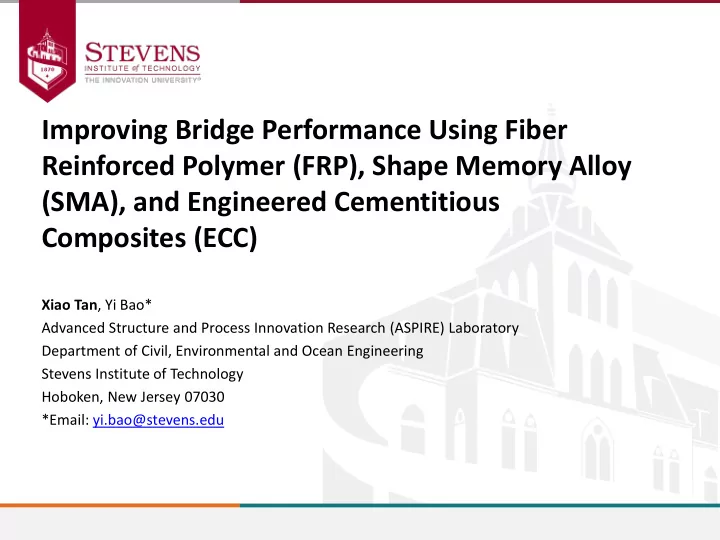

Improving Bridge Performance Using Fiber Reinforced Polymer (FRP), Shape Memory Alloy (SMA), and Engineered Cementitious Composites (ECC) Xiao Tan , Yi Bao* Advanced Structure and Process Innovation Research (ASPIRE) Laboratory Department of Civil, Environmental and Ocean Engineering Stevens Institute of Technology Hoboken, New Jersey 07030 *Email: yi.bao@stevens.edu
Outline • My research aims to improve bridge performance through using innovative materials. • This research addresses the following contents: Advantages of FRP, SMA and ECC; Applications in highway bridges; On-going research; Conclusions. 2
Fiber reinforced polymers • Combination of fibers in polymer matrix: Most loading is carried by the fibers Matrix provides support and keeps the fibers together Different types of fibers are used Glass, Carbon, Kevlar49, Boron, Silicon Carbide, etc. • Has many advantages High strength Lightweight Fatigue & corrosion resistance Low thermal conductivity & life-cycle cost 3
Shape memory alloys are smart materials • With unique capability to “remember” the original shape: Super-elasticity : Return to the original shape (6%~8% strain) Shape memory effect : Recover from large deformations after heating Super-elasticity Shape memory effect Tensile behavior of steels and SMA 4
Engineered cementitious composites (ECC) • ECC is a smart material with multiple unique properties and functions: Unique mechanical properties Tensile strain-hardening , high tensile ductility (4% strain) Excellent durability Flexural test of ECC Controlled crack width, self-healing of cracks Superior temperature resistance High-temperature, low-temperature Multi-functionality (smart functions) Self-sensing, self-cleaning, air-purifying, etc. 5
Applications in Highway Bridges • Lateral confinement of bridge piers Active confinement of concrete bridge piers with NiTiNb SMA spirals and FRPs • Innovative connection Column-footing connections in seismic zones with SMA bars and ECC • Bridge vibration control SMA devices for vibration isolation Cable damping devices 6
Lateral confinement of bridge piers SEM in constrained recovery Permanent prestressing after heating Lateral active confinement of bridge piers Comparison of force-displacement backbone curves of the four columns 7
Innovative connection Self-centering & self-healing of cracks 8
Isolate vibration with SMA devices • Improving the position stability of bridges • Benefits Improving safety and resilience under dynamic loadings Convenient installation and replacement 9
Cable vibration control with damping devices • The vibration amplitude of cables and hangers are reduced by 50% using SMA dampers, increasing the service life of the cables/hangers. A = structural cable, B = SMA damper, and C = accelerometer 10
On-going research 1: Improve fire resistance of highway bridges • Fire may result in permanent damage or even collapse of the bridge • We improve the fire resistance using prestressed Fe-SMAs and fire-resistive ECC 11
On-going research 2: Improve fatigue life of bridges Using SMAs and CFRP • An active retrofitting technique using SMA/CFRP composite • Crack-closing capability of SMA and fatigue resistance of FRP 12
Conclusions • The combination of FRPs, SMAs, and ECC demonstrated advantages in bridge engineering, especially in earthquake resistance design. • Active confinement delivered better performance of the bridge piers compared with the passive confinement strategy. • The piers with SMA/ECC connection recovered the position and demonstrated the minimal permanent drifts. • The SMAs are promising to control structural vibration , improve fire resistance , and enhance the fatigue resistance of bridges. 13
Recommend
More recommend